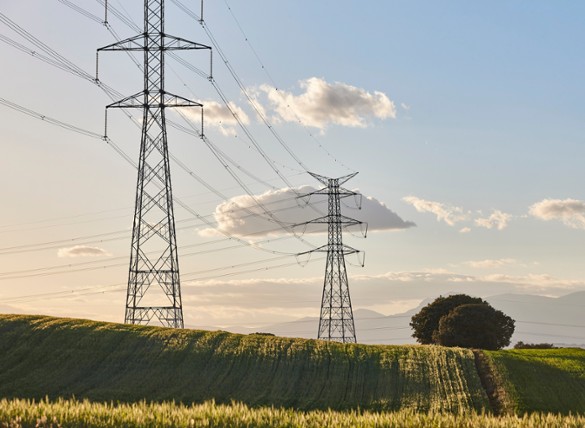Resilience with Upside in a Volatile Quarter
Q2 2025 Global Infrastructure Income Strategy Commentary
Key Takeaways
- Listed infrastructure was resilient during the market volatility in April, strongly outperforming the broader market, and remained steady through May and June while equities recovered from the selloff.
- Interest rate cuts from the European Central Bank and policy support such as Germany’s fiscal stimulus, with its focus on infrastructure spending, were positive for European utilities and renewables.
- We remain somewhat defensively positioned with an emphasis on utilities, which we find undervalued as peak bond yields have resulted in multiples coming down, although the utilities themselves have very strong growth profiles driven by AI data centre power demand, industry decarbonisation and resiliency spending.
Market Overview
Markets bounced back from a first-quarter correction and survived tariff, growth and geopolitical scares to deliver solid gains in the second quarter of 2025. Stocks fell to begin the quarter after U.S. President Trump unveiled wide-ranging reciprocal tariffs on April 2 but recovered as a delay in their implementation, a handful of bilateral trade deals and a softened tone from Trump on both China and Federal Reserve policy improved the outlook. The U.S.-China trade picture continued to brighten in May and June, ending in an agreement involving lower tariffs and increased exports of rare earth metals from China to the U.S. In June, an apparent end to the 12-day conflict between Israel and Iran, which threatened to raise oil prices and disrupt global shipping, added further support for risk sentiment.
Listed infrastructure was resilient during the market volatility in April, strongly outperforming the broader market, and remained steady through May and June while equities recovered from the selloff.
On a regional level, Western Europe was the strongest performer in the listed infrastructure universe we cover, where interest rate cuts from the European Central Bank and policy support such as Germany’s fiscal stimulus, with its focus on infrastructure spending, were positive for European utilities and renewables. Inflation concerns, elevated interest rates and expectations that tax incentives for renewables in the Inflation Reduction Act would be curtailed by the Trump administration kept a lid on infrastructure gains in the U.S.
Western Europe was the top regional contributor to Strategy returns for the quarter as well, with German electric utility E.On the lead performer. E.On is a European electric utility that runs one of the world’s largest investor-owned electric utility service providers and is the largest distribution system operator in Germany. Across Europe, it has 47 million customers. Continued momentum on structural reform in Germany and a huge potential run rate of grid investment helped E.On’s share price.
"Tariffs are unlikely to have a meaningful impact on utility earnings given they service domestic catchments and are not directly exposed to international trade."
U.S. electric utility Constellation Energy also outperformed for the quarter. Constellation is primarily a nuclear generation company and is the largest producer of carbon-free electricity in the U.S., serving states including New York, Illinois, Maryland, Pennsylvania and New Jersey. The company’s combined generation capacity is more than 32 GW and 90% of annual output is carbon free. Constellation’s share price benefited from the renewed optimism on data centre deals.
U.S. energy infrastructure company ONEOK and Canadian energy infrastructure company Pembina Pipeline were the largest detractors. ONEOK is one of the largest diversified energy infrastructure companies in the U.S., owning and operating an extensive network of natural gas liquids (NGL), natural gas, refined products and crude oil assets. Underperformance for the quarter was primarily driven by the OPEC+ decision to increase production and accelerate the unwinding of voluntary cuts, which ultimately led to further softening of the oil price outlook.
Pembina Pipeline provides transportation and midstream services for the energy industry in North America, with a focus on the Western Canadian Sedimentary Basin (WCSB). The market is currently focused on the outcome of toll renegotiations for the Alliance Pipeline, which has significantly over-earned in the last several years. We believe the market is overreacting to the potential normalisation in the tolling rate, which we believe will have only a low-single-digit impact on a group earnings basis. Looking beyond this, Pembina is positioned as a market leader in providing pipeline and midstream processing services to the fast-growing WCSB, which is seeing a step change in growth driven by liquified natural gas (LNG) and liquified petroleum gas (LPG) exports and a growing petrochemical industry in Alberta.
During the quarter, we initiated three new positions and exited four. An attractive valuation and dividend yield, along with our increased confidence that the IRA repeal will not materially impact the business, drove our purchase of U.S. renewables utility Clearway Energy. With tariff uncertainty dying down, improving second-quarter volumes, stronger pricing, easing cost inflation and increasing network fluidity driven by car velocity, we initiated a position in Canadian rail operator Canadian National Railway. We also bought Brazilian electric utility Copel as our research provided greater transparency into Copel’s attractive dividend policy.
Seeking to recycle capital for new opportunities, we exited several positions on strength, including Italian gas utility Italgas, German airport operator Fraport, which got a boost from German fiscal stimulus and the announcement of a multiyear rate plan, and U.K. electric utility National Grid. Due to continued complications related to the execution of its offshore wind assets, and with opportunities to deploy capital elsewhere, we also exited U.S. electric utility Dominion Energy.
Outlook
While the current environment is marked by heightened volatility and uncertainty, we remain confident in our utility and infrastructure assets and their ability to generate defensive, consistent and growing cash flow streams for shareholders over the medium to long term. Another key benefit of infrastructure investing is the pass-through of inflation – approximately 90% of our portfolio continues to benefit from direct or indirect inflation pass-through mechanisms.
Currently, we remain somewhat defensively positioned with an emphasis on utilities. We continue to find the sector undervalued, as peak bond yields have resulted in multiples coming down in that space. Nevertheless, the utilities themselves have very strong growth profiles, particularly in the U.S., driven by AI data centre power demand, industry decarbonisation and resiliency spending. At the same time, European utilities are getting more capex approved by regulators and are seeing returns tick up as well, providing robust long-term visibility in earnings growth. Further, in terms of tariffs, regulated utilities are largely insulated. Tariffs are unlikely to have a meaningful impact on utility earnings given they service domestic catchments with electricity, gas and water, and are not directly exposed to international trade. Overall, we believe infrastructure’s defensive characteristics and downside protection offer diversification in today’s uncertain market environment.
Portfolio Highlights
We believe an absolute return, inflation-linked benchmark is the most appropriate primary measure against which to evaluate the long-term performance of our infrastructure strategies. The approach ensures the focus of portfolio construction remains on delivering consistent absolute real returns over the long term.
On an absolute basis, the Strategy saw positive contributions from six of nine sectors in which it was invested in the quarter, with electric utility and renewables sectors the top contributors and energy infrastructure the main detractor.
Relative to the FTSE Global Core Infrastructure 50/50 and on a U.S. dollar basis, the Strategy outperformed in the second quarter, driven primarily by stock selection in the electric, gas and water utility sectors as well as an overweight to renewables. An underweight to airports and stock selection in the rails sector detracted.
On an individual stock basis, the top contributors to absolute returns in the quarter were Constellation Energy, E.On, EDP, SSE and Brookfield Renewable. The main detractors were ONEOK, Pembina Pipeline, NextEra Energy, Entergy and Redeia.
Related Perspectives

Infrastructure Outlook: AI, Decarbonisation and Policy Tailwinds in 2026
Structural tailwinds like decarbonisation, network upgrades and climate-proofing, along with AI’s need for power, are fuelling long-term capital expenditure cycles for infrastructure.
Read full article


